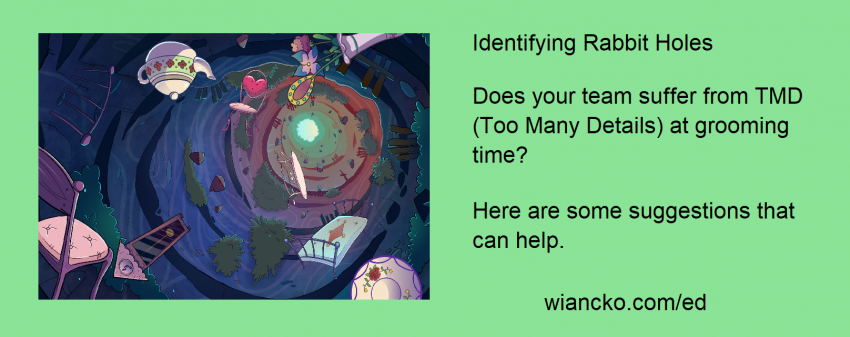Sometimes it hard to tell when a team is going into too much technical detail in a grooming session. Other times, it’s easy to tell, but hard to find a way to tactfully cut off the discussion. This short article will talk about how to detect the problem and ways to deal with it.
How to Know
Just like a doctor making a diagnosis, the following ‘symptoms’ can be hints to warn you that a team is suffering from a case of TMD (Too Much Detail):
- Time boxes frequently run out on team “debates”
- Only a couple stories get groomed in an hour
- Team needs more than one grooming session a week
- Team finds itself doing grooming during sprint planning
- Some team members are ‘disengaged’ while others are monopolizing the conversation

Be aware that cases of TMD can be categorized into at least two varieties: “Contentious TMD” and “Exuberant TMD.” The former may be characterized by raised voices and rabid white-boarding. The latter may be characterized by endless “what ifs” or boisterous anecdotes. In either case, the team experiences diminishing returns after a certain amount discussion.

This is from Mike Cohn’s book* “Agile Estimating and Planning.” Cohn talks about diminishing returns in the context of release planning, but it can be applied here in the smaller context of team grooming.
Taking Action (or “How to cut your team off … graciously!”)
As a leader, it’s your responsibility to take action. Here are three ways you can help your team avoid “rabbit hole” discussions.
One Person
When it’s one ‘frequent offender’ that’s steering the team into layer after layer of detail…someone who always seems to have another “well, but then there’s this…,” I’d suggest having a 1-to-1 talk with them.

Several years ago this I was dealing with this exact scenario. Let’s call the offender Jim.
I pulled Jim aside one day and, even though *he* was the cause, I said, “Jim, the team is having a problem. We are going into way too much detail in grooming and not getting enough done. Have you noticed this?” Jim agreed. I continued, “Could you help me watch for this problem and, when it happens, could you help steer the team back on track and help conclude the discussion?” “Sure,” he said.
To my satisfaction, it worked like an absolute charm!
Humor
When it’s everyone (or multiple people) taking the discussion too deeply, try using humor.
Different team (but also several years ago) one of my groups would fall into spirited discussions that never seemed to end. The system and the tools were both new ground for everyone, so even the Engineering Manager was participating in the debate that was going back and fourth…and back…and fourth… So, at the next grooming, I brought a little wind-up, jumping bunny toy.**

At the start of next grooming session, I told the team “Now we’ve been consuming a lot of extra time lately due to deep, technical discussions. So, I brought in this guy [showed the rabbit]. Whenever anyone feels that we are ‘going down the rabbit-hole,’ I want you to grab the rabbit, wind him up, and set him loose on the table.” Everyone found the concept amusing. But, would it work in practice…?
The first time it was used, the laughter brought things to a halt. Then a look of recognition came over everyone. The team began to wrap up the discussion and we turned our attention to putting points on the story. Later on, all someone had to do was start reaching for the rabbit. At that moment the person speaking would acknowledge that the discussion was getting long and they, and the team, would change focus to winding the debate down.
Ask The Team
I’ve long since lost track of the rabbit, but with my current teams I will simply and politely raise my hand as if I were in a class waiting to be called on. I ask one simple question:
“Do we know enough about this story to point it?”
Many times the answer is ‘yes.’ So, final thoughts are shared and we move on to pointing poker.
Sometimes, however, the answer will be “no.” If significant time has passed and the answer is still “no,” then maybe it’s time to “spike it.” In that case, we’ll setup a story for some research and next grooming session the actual work can be pointed.
In Conclusion
When a team is spending too much time in grooming, sometimes it helps to remind them the goal is not to know every detail, but rather to simply know enough to be able to group the story with others of a similar size (i.e. “put the right number of points on it”).
From time to time almost any team can slip into a rabbit hole of technical detail. As a leader, you need to keep watch for this and find ways to graciously cure the “flare-up” of TMD (Too Much Detail). Sometimes it’s as simple as asking them. The techniques mentioned in this article will help you keep your team on the right path.
How Have You Helped Teams?
Maybe you have additional tips or experiences you’d like to share. I’d love to hear them.
References
- *Mike Cohn’s “Agile Estimating and Planning”
- **If I recall correctly, Brian Hall, inspired the idea of interrupting a ‘rabbit hole’ discussion with a comedic gimmick of some sort.
